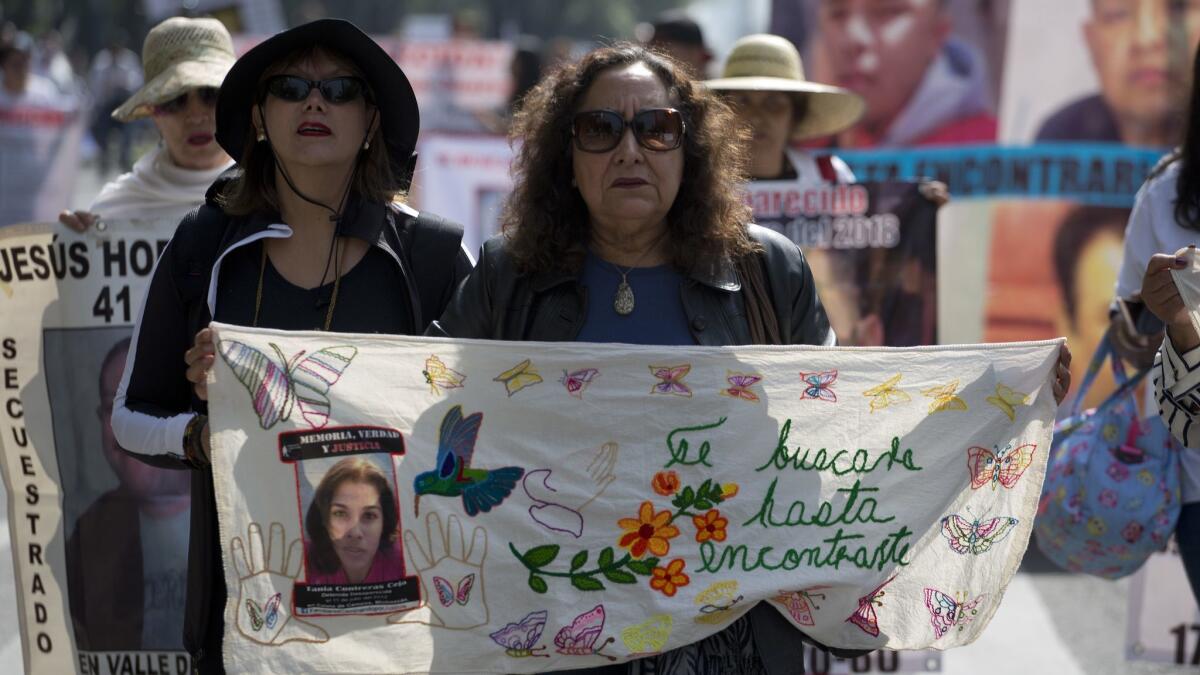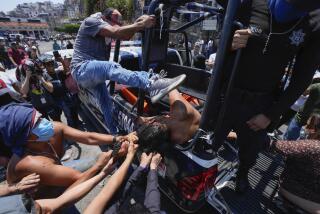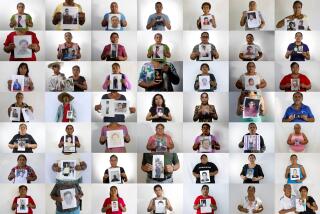Must Reads: In Mexico, a doleful Mother’s Day for those whose children are among the ‘disappeared’

The forlorn marchers filed down Paseo de Reforma, the grand, tree-lined boulevard that runs through the heart of the Mexican capital.
“Where are our children?” they chanted.
Many of the hundreds of marchers hoisted placards with images of loved ones. Some donned T-shirts emblazoned with blown-up snapshots of sons and daughters, all appearing larger than life, inevitably flashing bright smiles.
“Where are they?” the people demanded. “Dónde están?”
Mexico on Thursday celebrated Mother’s Day, a holiday that is far more than a greeting-card moment across the country. Politicians and others pay public homage to motherhood, merchants hawk mom-themed balloons, T-shirts and trinkets, flower stands do a booming trade and children escort smartly outfitted mamás to heavily booked restaurants.
But Mother’s Day in Mexico has in recent years become the date of a doleful annual tradition— so-called dignity marches to call for justice in the cases of tens of thousands of Mexicans whose whereabouts are unknown, mostly since the nation declared its war on drug traffickers in 2006. The missing are called the “disappeared,” and most are believed to have been abducted and killed.
Thursday marked the seventh consecutive year of Mother’s Day protests in Mexico City highlighting the fate of the disappeared. Hundreds of mothers and others assembled from across the country. Similar demonstrations were held in other cities.
For these mothers — and for other relatives of the disappeared — Mother’s Day has become a day of protest and remembrance, not a time for family dinners and festivities.
“I cannot sit down with my family for a Mother’s Day meal in peace,” said Leticia Vasquez, 59, who was among those who made their way down Paseo de la Reforma to Mexico’s landmark Angel of Independence monument, where participants held a rally beneath an unforgiving sun.
Vasquez held a yellow placard featuring the image of a smiling, dark-haired young woman and the plea: “Help me find Erika.”
Erika Cueto Vasquez, her daughter, vanished Nov. 12, 2014, in the coastal resort town of Puerto Vallarta. She was 39. Five days later, authorities found her car abandoned in a gully, repainted pink from its original white. There was no sign of Erika.
“They took away part of my soul,” said her mother, referring to criminals who, she says, kidnapped her daughter. ”I will never stop trying to find her, to find out what happened to her.”
The ranks of Mexico’s missing include men and women, the elderly and the young, rich and poor, police officers and multitudes of people with no criminal history who were abducted and never seen again — usually for reasons that remain opaque.
In many cases, those who disappeared were not suspected of having done anything illegal or even improper.
Authorities say that was the case in the abduction of three film students whose disappearance in March sparked a wave of protests in Guadalajara, Mexico’s second-most populous city. A drug-trafficking gang snatched the three in an apparent case of mistaken identity, tortured them, killed them and dissolved their bodies in acid, according to prosecutors.
Police have arrested several suspects, reportedly including a rap singer with a large online following who told authorities he was paid the equivalent of about $166 per corpse to dissolve bodies in acid.
Still unresolved is another high-profile case: The disappearance of 43 teacher trainees in 2014 in Guerrero state. Authorities have given conflicting accounts of their fate, though it appears the students were intercepted by police and handed over to traffickers, who executed them.
The Mexican government says more than 34,000 people are categorized as disappeared, including some who vanished decades ago. Activists in Mexico’s growing disappeared movement say the number is much higher, but they contend that politicians and prosecutors are not especially keen to highlight what is somewhat of a taboo topic.
It’s a presidential election year in Mexico and, while rising crime is a major campaign theme, the issue of the disappeared has received scant attention. The matter didn’t come up at last month’s presidential debate, which wast mostly focused on security issues.
There was no official comment Thursday from the Mexican government about the marches. Publicly, government officials have vowed to investigate fully the cases of the disappeared, but activists call the vows hollow.
Mexican President Enrique Peña Nieto sent a Twitter message Thursday saluting the “mothers of Mexico” but mentioned neither the marches nor the disappeared.
“We are forgotten — it’s not in the politicians’ interest to even recognize our loss,” said marcher Rosa Hilda Cisneros, 55, who held a laminated poster bearing the photograph of a smiling woman and the text: “I am Dulce Yamelli Cisneros Garcia.”
Cisneros’ daughter, Dulce Yamelli, has not been seen since May 12, 2012. That was the day, Cisneros recalls, that attackers armed with assault rifles descended on the family clothing store in the town of San Fernando in northern Tamaulipas state, among the most violent in Mexico, a key drug-smuggling corridor to the United States.
The assailants seized mother and daughter. Cisneros says she was released a few hours later after her husband managed to put together a ransom of 1.2 million pesos, or about $90,000 at the exchange rate at the time. But her daughter has never been seen again, she says.
“We are like ghosts, like sleepwalkers, wandering about, wondering what happened to our children,” said Cisneros. “The police don’t help us. No one cares. But we are here to show we have not forgotten. And we demand justice and transparency. These are our children.”
Cisneros says she has since left the town of San Fernando, which has been the site of several notorious massacres attributed to cartels. Activists in the disappeared movement have themselves received threats, and worse.
Miriam Elizabeth Rodriguez, a leading disappeared activist and friend of Cisneros, had pressured authorities to investigate the fate of her daughter, who was kidnapped in 2012. The mother’s insistence helped lead to the discovery of the partial remains of her daughter in a clandestine grave. Rodriguez sought police protection, colleagues say, and felt her life was in danger.
On Mother’s Day last year, Rodriguez was shot dead at her home in San Fernando. Police have arrested several suspects in Rodriguez’s slaying and say another was killed in a confrontation with authorities.
Throughout Mexico, relatives have organized into brigades to dig for corpses of the disappeared dumped in secret graves scattered across the country.
Marchers on Thursday recounted the anguish of not knowing the fate of missing kin. Many said they had no idea why their loved ones were abducted. All spoke of frustration with what they termed halfhearted investigations by Mexican police, who have often been implicated in disappearances.
“The authorities were not only inept, they were also cruel,” said Maria Elizabeth Toxtle, 54, recalling when her family reported the disappearance of her son, Michell Jimenez Toxtle, 21, a gas company worker who never arrived home for dinner on Feb. 18, 2016.
“They told us that maybe he had gone to the United States as an ‘illegal,’ or maybe he had run away with his girlfriend,” Toxtle said. “That’s all ridiculous, all pretexts to not look for him. He had no need to go to the United States. And his girlfriend is here, also looking for him.”
Mostly there was profound sadness, mixed with outrage at government inaction, among the Mother’s Day marchers. All professed hope that their missing loved ones may still be alive, though many acknowledged that the prospect is increasingly unlikely as the months and years drag on. That perception of possible survival, of course, remains most vivid among those whose relatives vanished relatively recently.
“I am here to beg the government, the president, that they take notice of our suffering and that they help us to look for our children,” said Margarita Castillo Puentes, 48, a hair stylist from Puebla state. “I cannot stop crying thinking of what happened to my son, where he is. I pray to God every day that he is well, that he is alive. I try to be strong, but my life has fallen apart.”
Her son, Angel de Jesus Gonzalez Castillo, 20, disappeared March 8 in the town of Xicotepec in Puebla state after he went out with a friend, she said.
“Today is Mother’s Day, and the best gift would be that they return our children,” said Puentes. “Today I have nothing to celebrate. These have been the most painful two months of my life.”
Cecilia Sanchez of The Times’ Mexico City bureau contributed to this report.
Twitter: @PmcdonnellLAT
More to Read
Start your day right
Sign up for Essential California for news, features and recommendations from the L.A. Times and beyond in your inbox six days a week.
You may occasionally receive promotional content from the Los Angeles Times.






